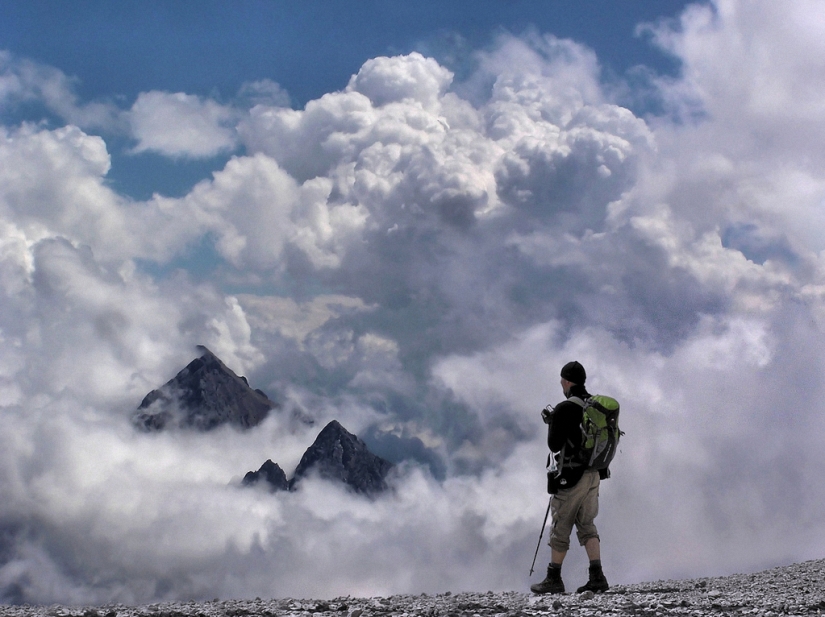How long can the human body withstand
Categories: Food and Drinks | Health and Medicine | Healthy lifestyle | People | Science | Society | Water | World
By Vika https://pictolic.com/article/how-long-can-the-human-body-withstand.htmlThe human body is very delicate. Without additional protection, it can function only in a narrow temperature range and at a certain pressure. It must constantly receive water and nutrients. And it will not survive a fall from a height of more than a few meters. How much can the human body withstand? When does our body face death? Pictolic brings to your attention a unique overview of the facts about the limits of survival of the human body.
8 PHOTOS

1. Body temperature.
Survival limits: body temperature can vary from + 20 ° C to + 41 ° C.
Conclusions: usually our temperature ranges from 35.8 to 37.3 ° C. Such a temperature regime of the body ensures the smooth functioning of all organs. At temperatures above 41 ° C, significant fluid loss, dehydration, and organ damage occur. At temperatures below 20 ° C, blood flow stops.
The human body temperature is different from the ambient temperature. A person can live in an environment with temperatures ranging from -40 to + 60 ° C. It is interesting that a decrease in temperature is just as dangerous as its rise. At a temperature of 35 ° C, our motor functions begin to deteriorate, at 33 ° C we begin to lose orientation, and at a temperature of 30 ° C, we lose consciousness. A body temperature of 20 ° C is the limit below which the heart stops beating and a person dies. However, medicine knows a case when a man was saved, whose body temperature was only 13 ° C. (Photo: David Martín / flickr.com).

2. The efficiency of the heart.
Survival limits: 40 to 226 beats per minute.
Conclusions: a low heart rate leads to a decrease in blood pressure and loss of consciousness, too high - to a heart attack and death.
The heart must constantly pump blood and distribute it throughout the body. If the heart stops working, brain death occurs. The pulse is a wave of pressure induced by the release of blood from the left ventricle into the aorta, from where it is distributed throughout the body by arteries.
Interestingly, the "life" of the heart in most mammals averages 1,000,000,000 beats, while a healthy human heart performs three times as many beats in its entire life. A healthy adult heart beats 100,000 times a day. In professional athletes, the resting heart rate is often as low as 40 beats per minute. The length of all blood vessels in the human body, if they are connected, is 100,000 km, which is two and a half times longer than the length of the Earth's equator.
Did you know that the total power of the human heart for 80 years of human life is so great that it could drag a steam locomotive to the highest mountain in Europe - Mont Blanc (4810 m above sea level)? (Photo: Jo Christian Oterhals / flickr.com).

3. Overloading the brain with information.
Survival limits: each person is different.
Conclusion: Information overload leads to the human brain falling into a state of depression and no longer functioning properly. The person is confused, begins to carry delirium, sometimes loses consciousness, and after the disappearance of the symptoms, he does not remember anything. Prolonged brain overload can lead to mental illness.
On average, the human brain can store as much information as 20,000 average dictionaries contain. However, even such an efficient body can “overheat” due to the excess of information.
Interesting: the shock resulting from extreme irritation of the nervous system can lead to a state of numbness (stupor), while the person ceases to control himself: he can suddenly come out, become aggressive, speak nonsense and behave unpredictably.
Did you know that the total length of nerve fibers in the brain ranges from 150,000 to 180,000 km? (Photo: Zombola Photography / flickr.com).

4. Noise level.
Survival limits: 190 decibels.
Conclusions: at a noise level of 160 decibels, eardrums begin to burst in humans. More intense sounds can damage other organs, particularly the lungs. The pressure wave tears the lungs apart, causing air to enter the bloodstream. This, in turn, leads to blockage of the blood vessels (embolism), which causes shock, myocardial infarction, and ultimately death.
Typically, the range of noise we experience ranges from 20 decibels (whispering) to 120 decibels (airplane taking off). Everything that is above this border becomes painful for us. Interesting: being in a noisy environment is harmful to a person, reduces his effectiveness, and distracts. A person is not able to get used to loud sounds.
Did you know that loud or unpleasant sounds are still used, unfortunately, during the interrogation of prisoners of war, as well as during the training of special services soldiers? (Photo: Leanne Boulton / flickr.com).

5. The amount of blood in the body.
Survival limits: loss of 3 liters of blood, that is, 40-50 percent of the total amount in the body.
Conclusions: a lack of blood leads to a slowdown in the work of the heart because it has nothing to pump. The pressure drops so much that the blood can no longer fill the chambers of the heart, which leads to its arrest. At the same time, the brain does not receive oxygen, stops working and dies.
The main task of the blood is to distribute oxygen throughout the body, that is, to oxygenate all organs, including the brain. In addition, blood removes carbon dioxide from tissues and carries nutrients throughout the body.
Interesting: the human body contains 4-6 liters of blood (which is 8% of the bodyweight). The loss of 0.5 liters of blood in adults is not dangerous, but when the body lacks 2 liters of blood, there is a great risk to life, in such cases, medical attention is needed.
Did you know that other mammals and birds have the same blood-to-body weight ratio - 8%? And the record amount of blood lost in a person who did survive was 4.5 liters? (Photo: Tomitheos / flickr.com).

6. Height and depth.
Survival limits: -18 to 4500 m above sea level.
Conclusions: if a person without training, who does not know the rules, and also without special equipment dives to a depth of more than 18 meters, he is in danger of ruptured eardrums, damage to the lungs and nose, too high pressure in other organs, loss of consciousness and death from drowning. Whereas at an altitude of more than 4500 meters above sea level, a lack of oxygen in the inhaled air for 6-12 hours can lead to pulmonary and cerebral edema. If a person cannot descend to a lower altitude, he will die.
Interesting: an unprepared human body without special equipment can live in a relatively small range of heights. Only trained people (divers and climbers) can dive to a depth of more than 18 meters and climb the mountain peaks, and even they use special equipment for this - diving cylinders and climbing equipment.
Did you know that the record in diving with one breath belongs to the Italian Umberto Pelizzari - he dived to a depth of 150 m.During the dive, he experienced tremendous pressure: 13 kilograms per square centimeter of body, that is, about 250 tons for the whole body. (Photo: B℮n / flickr.com).

7. Lack of water.
Survival limits: 7-10 days.
Conclusions: lack of water for a long time (7-10 days) leads to the fact that the blood becomes so thick that it cannot move through the vessels, and the heart is unable to distribute it throughout the body.
Two-thirds of the human body (weight) consists of water, which is necessary for the proper functioning of the body. The kidneys need water to remove toxins from the body; the lungs need water to moisturize the air we exhale. Water also participates in the processes taking place in the cells of our body.
Interesting: when the body lacks about 5 liters of water, a person begins to feel dizzy or faint. With a lack of water in the amount of 10 liters, severe convulsions begin, with a 15-liter water shortage, a person dies.
Did you know that in the process of breathing we consume about 400 ml of water every day? Not only the lack of water can kill us, but its excess. Such a case happened to one woman from California (USA), who during the competition drank 7.5 liters of water in a short period of time, as a result of which she lost consciousness and died a few hours later. (Photo: Shutterstock).

8. Hunger.
Survival limits: 60 days.
Conclusions: The lack of nutrients affects the functioning of the whole organism. In a starving person, the heart rate slows down, the level of cholesterol in the blood rises, heart failure occurs and irreversible damage to the liver and kidneys occurs. A person exhausted by hunger also has hallucinations, he becomes lethargic and very weak.
A person eats food to provide himself with energy for the work of the whole body. A healthy, well-nourished person who has access to sufficient water and is in a friendly environment can survive without food for about 60 days.
Interesting: the feeling of hunger usually appears a few hours after the last meal. During the first three days without food, the human body expends energy from the food that was eaten last. Then the liver begins to break down and consume fat from the body. After three weeks, the body begins to burn energy from the muscles and internal organs.
Did you know that American Amerykanin Charles R. McNabb, who in 2004 went on hunger strike for 123 days in prison for the longest time without food, survived? He only drank water, and sometimes a cup of coffee.
Did you know that about 25,000 people die of hunger every day in the world? (Photo: Rubén Chase / flickr.com).
Keywords: World | Society | Health | Healthy lifestyle | People | Human | Human body | Facts | Statistics | Temperature | Protection | Nutrition | Food and drinks | Survive | Life
Post News ArticleRecent articles

Thailand is a kingdom of amazing beauty, where the colors of nature mingle in a captivating palette of rich and varied landscapes. ...

Hamsters are one of the cutest animals in the world, and they are quite easy to keep. No wonder they are so popular. We have ...
Related articles

Walking through this picturesque bridges, you can admire the views from these stunning views and breathtaking landscapes. We invite ...

Not all the house where they filmed the cult movies and TV shows, become "house-museums". Many of them are then sold as the ...

Inspired by the observations of the countryside around Epping in Essex, where she grew up, Jill Barklem came up with a series of ...

May West once jokingly said that she should be given a license to invent sex, which she discovered for Americans. The name of this ...